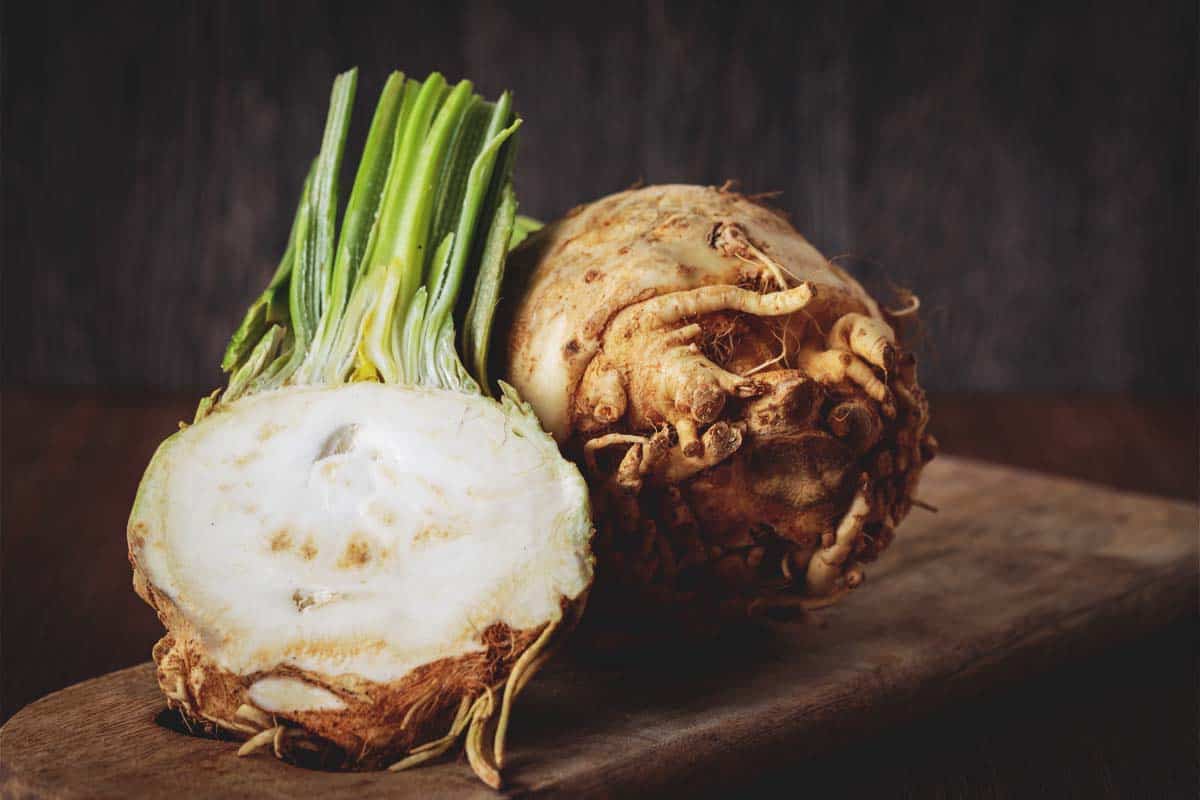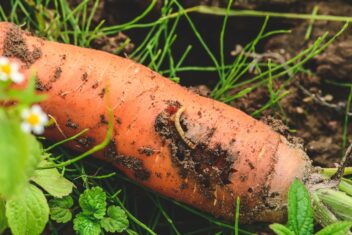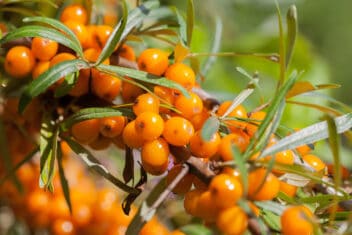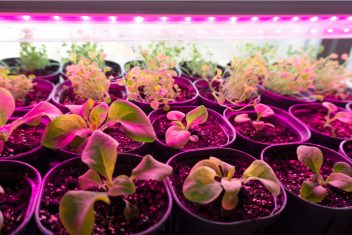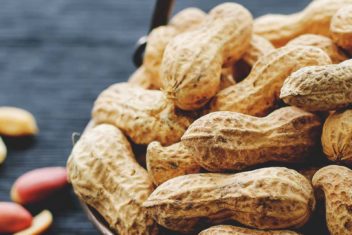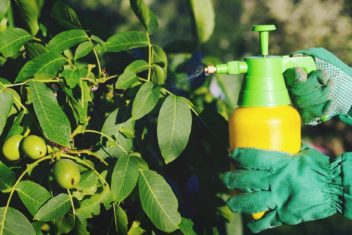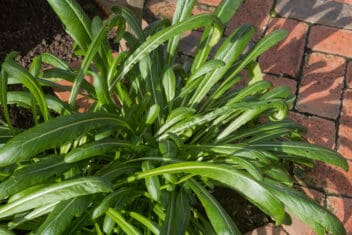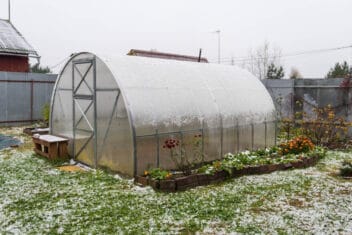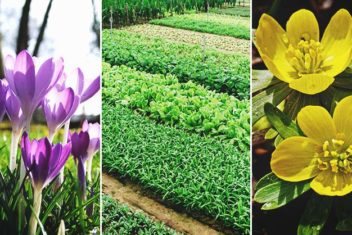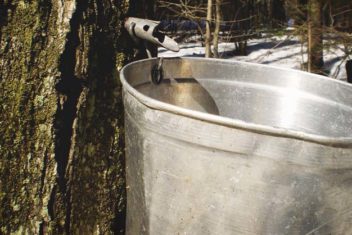It’s one of the ugliest vegetables you’ll encounter in your CSA basket or at the farmer’s market, but it’s also surprisingly flavorful and incredibly versatile in the kitchen. Welcome to the weird and wonderful root of the celeriac plant.
It amazes me that certain plants, celeriac included, haven’t ever been the trending veg of the year. Is it because of its odd appearance? Is it because people don’t all enjoy the complex flavor profile of this unusual vegetable? What’s the deal? Whatever it is, I vote for celeriac to be vegetable of the next decade! Forget cauliflower and kale. This lumpy root deserves its moment in the spotlight.
If that doesn’t happen, though, it’s easy enough to succeed at growing celeriac in your own garden. Read on to find out how to cultivate it in your patch of dirt.
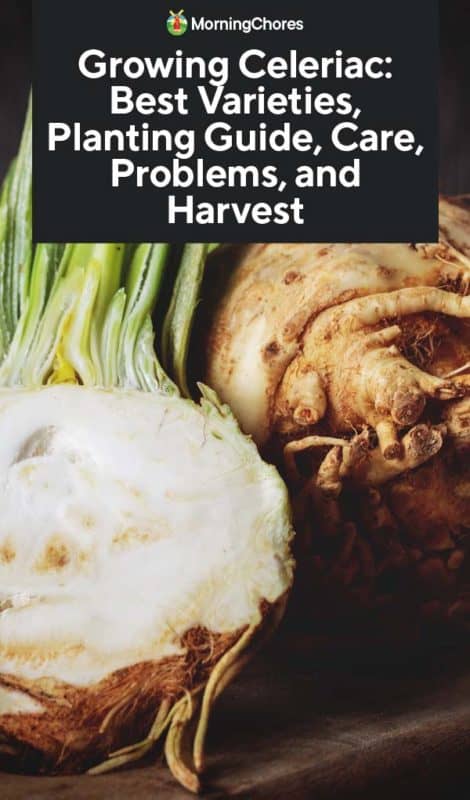
What is Celeriac?
The weird-looking vegetable, sometimes known as celery root or knob celery, is a kind of celery grown primarily for its tasty root. Like celery, it’s part of the parsley family (Umbelliferae). Although you might not see this vegetable as often, it’s easier to grow than its cousin, and it’s also an incredibly versatile kitchen ingredient.
Celeriac varieties
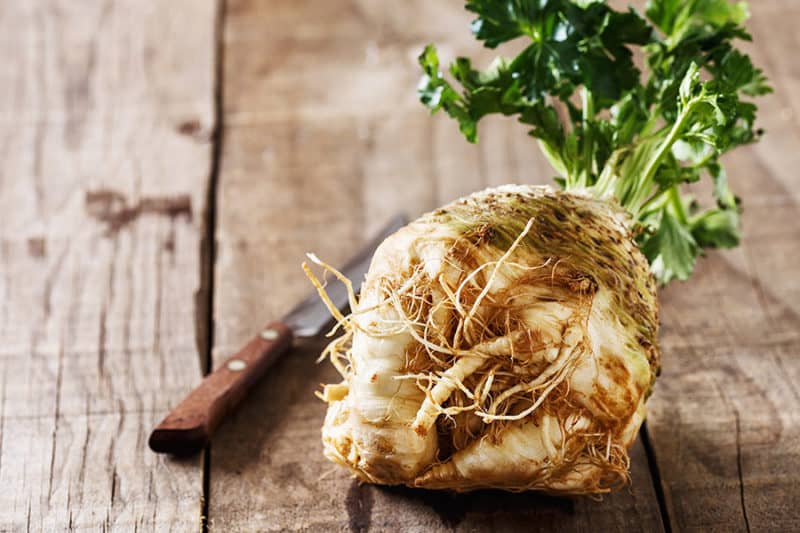
Celeriac originated in the Mediterranean but is now cultivated in multiple parts of the world. Here are some varieties of celeriac you can try growing:
- Alabaster: This type has a pronounced celery flavor. The bulb retains its coloring when cooked.
- Brilliant: Produces round roots of medium-size. Smoother than other varieties.
- Giant Prague: This type produces large white roots and has a strong celery flavor. The variety originated in 1871.
- Mars: Mars plants grow nice and big with uniform roots.
- Monarch: Easy to grow and peel thanks to a smooth exterior. Monarch tastes excellent raw or cooked.
- Prinz: This type produces smaller plants with smooth white skin.
Planting celeriac
The plant is easy to grow compared to celery, but it does require plenty of patience. While celeriac is technically a biennial, it’s usually grown as an annual.
Sun Requirements
Celeriac likes full sun but won’t scoff at some shade in particularly warm areas.
Soil Requirements
Soil should not be waterlogged, but it should be rich and able to conserve moisture readily. Prepare beds by amending with compost – celeriac likes fertile soil. Aim for a pH between 6-6.5.
Plant in the ground – this vegetable doesn’t fare well in containers.
When to Start
The cool-season vegetable should be started indoors about 10 weeks before your usual last frost date. It takes a while to mature, so starting indoors is especially important in regions with short growing seasons.
Starting Seeds
Soaking the seeds prior to planting helps promote sprouting. Germination can take up to three weeks, so be patient. Unlike some other types of seed, germination rates are usually around 50%. Plant seeds 1/8-1/4 inch deep.
Planting Outside
Timing is essential because the vegetable is technically a biennial. To grow it as an annual, set it out at the right time when temperatures are warmer and not below 55°F. The seedlings should be 4-5 tall.
In colder regions where the spring weather is temperamental, it may be necessary to utilize crop protection like hoop houses or greenhouses or simply wait until it’s warm enough outside to transplant. Harden off plants for 7-10 days.
In most cases, direct sowing outdoors is simply not feasible.
Spacing
Celeriac seedling should be thinned to 6 to 8 inches apart. They should be spaced in the garden 6-12 inches apart with 18 inches between rows.
Caring for Celeriac
Growing celeriac takes patience, plenty of water, and a little care.
Watering
The shallow-rooted plant requires regular watering. Drought causes stunted growth. Keep the soil moist but not waterlogged at all times.
Weeding
Remove weeds quickly, but don’t be too aggressive since the shallow roots are easy to disturb and damage.
Fertilizing
Celeriac is a heavy feeder, so add compost prior to planting and redress halfway through the season. Add a monthly all-purpose fertilizer.
Mulching
The topsoil should be moist at all times, so add mulch to retain moisture.
Succession planting
Celeriac has such a long growing season that it’s not the right candidate for succession planting.
Problems and Solutions to Growing Celeriac
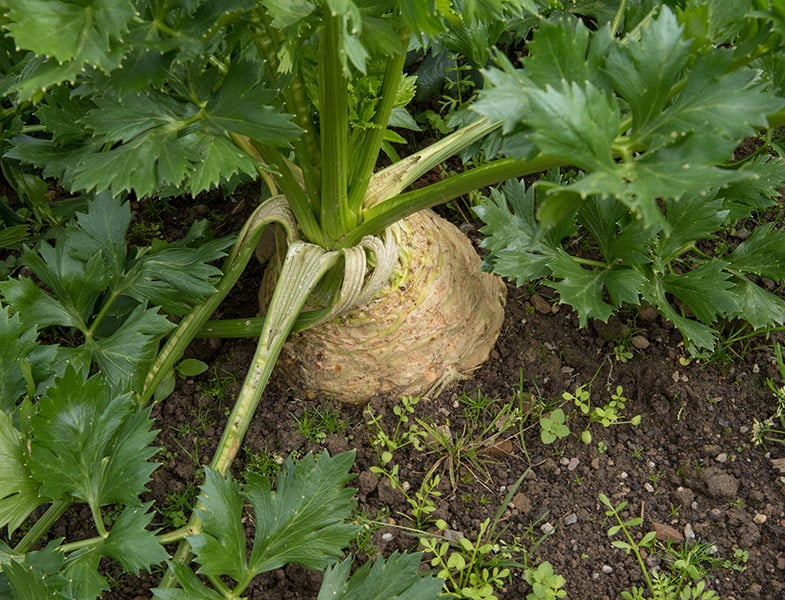
You’re in luck! The bulbous vegetable doesn’t have too many pests or disease problems of note. Here are a few potential issues you may encounter when growing celeriac:
Pests
- Aphids: Are there any plants aphids don’t like? Blast them off the growing celeriac plants with a strong spray of water. Apply neem oil regularly to discourage them from returning.
- Slugs: In the damp spring, slugs may be attracted to your baby celeriac plants.
- Carrot rust fly: These little gnat-like bugs aren’t a common celery root pest, but if there’s an infestation, they can quickly kill your celeriac plant. Proper soil maintenance and crop rotation practices should eliminate pest problems altogether.
- Cutworms: These worms cut plants off at the base, killing them. Use plant collars and diatomaceous earth to control them.
Diseases
- Leaf Blight: There are two kinds of blights that attack celeriac. Early blight causes necrotic brown spots with a yellow halo to form on leaves. Late blight causes brown spots that spread until the entire leaf becomes dry. Soak seeds in a formaldehyde solution for 30 minutes to prevent.
- Celery Mosaic: This disease causes foliage to turn yellow with a mottled pattern. It’s carried by aphids, so keep them away. Be sure to weed so avoid the spread.
Problems
- Early flowering: Celeriac is a biennial, so if you transplant too early you confuse the plant into thinking it’s in its second year. You won’t get the edible root bulb if this occurs, so pay careful attention to the temperature when deciding when to transplant.
- Small roots: Irregular watering or lack of moisture creates stunted, small roots, so be sure to water frequently and mulch to conserve moisture. Poor weather conditions are another potential culprit. Unseasonably cold weather during the summer can keep bulbs small.
- Celeriac seeds aren’t germinating: It may take a while for the seeds to germinate. Even then, the average germination rates for this type of seed are relatively low. If you’re getting everything right (meaning all your other seeds are sprouting fine), it might be a case of bad luck, unfortunately.
Companion Planting for Celeriac
Here’s a list of companions too try growing with your celeriac plants.
- Brassicas
- Allium vegetables
- Tomatoes
- Lettuce
- Spinach
- Peas
- Beans
These bad companions compete with celeriac for water and nutrients:
- Corn
- Cucumbers
- Squash
- Pumpkins
Harvesting and Using Celeriac
It’s time to harvest the root of your plant when it’s between 3 to 4 inches in diameter, typically 110 days after sowing. You’ll achieve the best-tasting root if you wait to harvest after a light frost. Don’t wait too long, a hard freeze may make it difficult to pull the root from the ground.
There’s contradicting wisdom out there about whether it’s best to harvest when the root is small or large, but the consensus seems to be that larger bulbs don’t become woody like other types of root vegetables.
Once harvested, the vegetable keeps for up to a week in the fridge. If you have a root cellar, you can store celeriac for 3 months or more. Keep temperatures between 32-41°F for maximum storage potential. Over time, the root vegetable loses its flavor so older bulbs will be less pungent than young ones.
Cooking with Celeriac
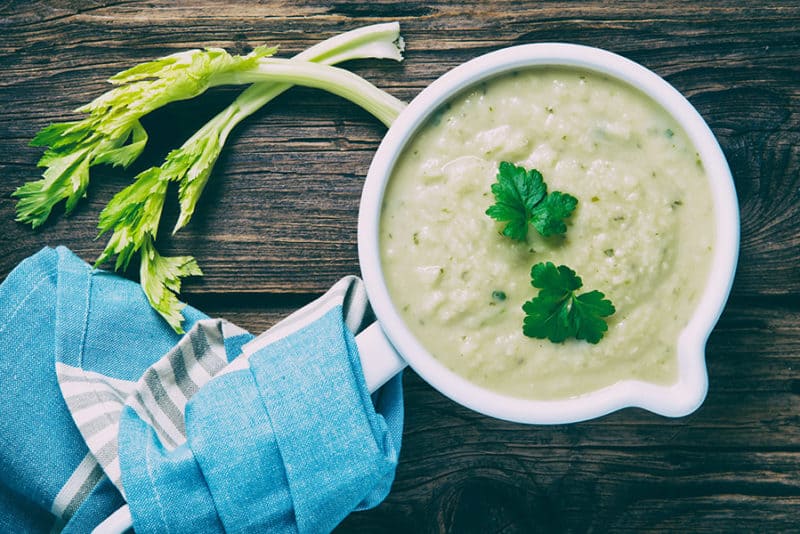
All parts of the celeriac plant are edible, including the leaves. It’s not a beautiful vegetable, but it tastes great!
Before cooking the knobby sphere, you’ll need to peel it and cut away the fibrous bits. You can cook it in a variety of ways – boil it, roast it, sauté it. I’m a fan of boiling and mashing as a substitute for mashed potatoes.
Cook celeriac quickly to prevent the browning that occurs when the bulb interior is exposed to air.
Here are a few recipes to help you discover this unusual vegetable:
- A creative way to utilize that CSA basket celeriac is with this low-carb celeriac soup with bacon and parmesan. The addition of those two delicious ingredients never fails to make anything flavorful.
- This creamy celeriac soup from Feasting At Home is a comforting, satisfying way to enjoy this hearty root vegetable.
- I didn’t notice the author of this celeriac and lentils with hazelnut and mint recipe until after I read through the ingredients. Once I saw it was an Ottolenghi dish, everything became clear. This is a gourmet way to utilize a knob of celeriac.
- There are no noodles in this chickpea soup. Instead, the recipe includes spiralized celeriac. It’s definitely a unique way to incorporate the vegetable into a dish.
- It’s kind of tough to scoff at anything topped with cheese. This celeriac and leek au-gratin recipe is the perfect side dish for a holiday meal.
- While the recipe step to mash the cubes is optional, I recommend doing so. Mashed celeriac is an excellent alternative to mashed potatoes when you have no taters in the cupboard or want to change up your usual meat and potatoes dish.
The Health Benefits of Celeriac
The mild-tasting cousin to celery is a nutrient-dense vegetable packed with vitamins and lots of fiber. It’s a hearty source of vitamin C, B6, and K. It’s antioxidant-rich and also a good source of phosphorus, manganese, and potassium.
What does the research say about celeriac? There’s evidence that the vegetable has the potential to regulate blood pressure, improve gut health, and strengthen bones.
The Bottom Line on Growing Celeriac
Have you ever tried growing celeriac? Do you also grow celery? Which is your favorite to cultivate? Let us know about your struggles and successes with celeriac. We’d also love it if you shared your favorite ways to prepare the vegetable – the more people who grow to love this strange veggie the better!
